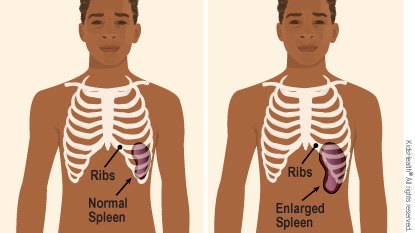Splenic sequestration (SPLIN-ik see-kweh-STRAY-shen) happens when sickle-shaped cells block blood flow in the spleen, making it get large and painful. When these cells get trapped in the spleen, there are suddenly too few oxygen-carrying blood cells circulating in the blood, leading to low hemoglobin. Your child was treated for splenic sequestration and is doing better. Follow these instructions to care for your child at home.



Your child has:
The hematologist knows your child's health better than any other health care provider. So it's always best to call them when there's a problem.

Your child:
When you call 911, tell emergency responders that your child has sickle cell disease.

What does the spleen do? The spleen:
Why does splenic sequestration happen? Sickle cells are pointy, stiff, and sticky and can get stuck in the spleen's blood vessels.
How is splenic sequestration treated in a hospital? Kids with splenic sequestration get fluids through an IV, and sometimes blood transfusions. IV fluids help to "flush" the trapped cells out of the spleen. In a red blood cell transfusion, the new transfused blood cells can carry oxygen to the spleen and the rest of the body. After the spleen gets more oxygen, it releases the trapped blood cells and gets smaller, and the child starts to feel better.
Can my child get splenic sequestration again? Yes. Kids who have had splenic sequestration are more likely to have it again. Make sure you and your child know the signs so you can get treatment quickly if it happens again. Watch for: